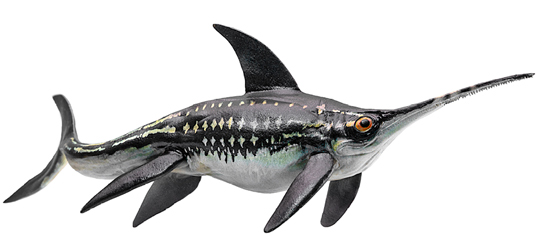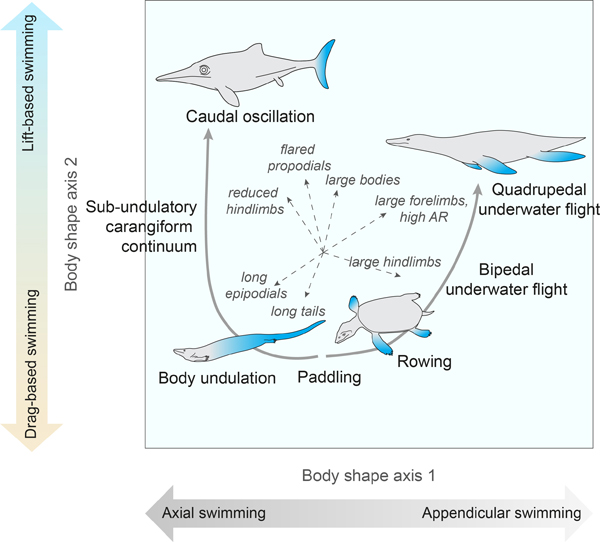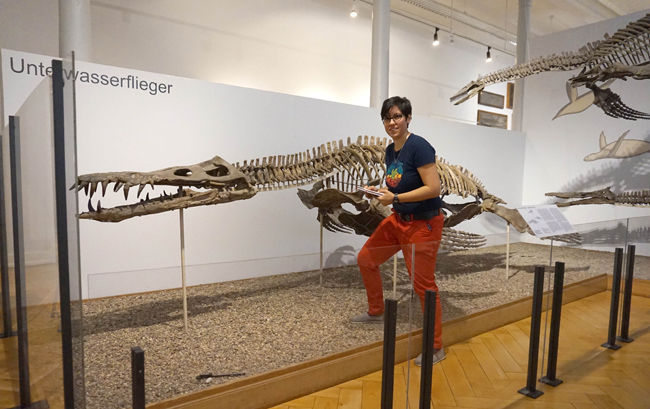Mapping Marine Reptiles Thanks to New Research
Whilst the Dinosauria dominated terrestrial environments during the Mesozoic the seas and oceans of the world were home to a diverse assemblage of marine reptiles. Many different types of marine reptile evolved, and the diverse swimming techniques employed by these ancient animals have been revealed in a recently published scientific paper.
The swimming secrets of Mesozoic marine reptiles have been decoded thanks to a research team from the University of Bristol.

The image (above) shows a replica of an Eurhinosaurus. An ichthyosaur (Leptonectidae family) that lived during the Early Jurassic (approximately 180 million years ago).
The model is from the PNSO range of figures: PNSO Age of Dinosaurs.
Marine Reptile Diversity During the Mesozoic
During the Mesozoic, which lasted from approximately 252 million years ago to the end-Cretaceous mass extinction event around 66 million years ago, many different types of marine reptile evolved. There were placodonts, turtles, the first ichthyosaurs and nothosaurs during the Triassic and these were replaced by marine crocodiles, derived ichthyosaurs, long-necked plesiosaurs and pliosaurs. During the Cretaceous the mosasaurs evolved.
In the new paper, published in the academic journal “Palaeontology”, the research team report on the use of cutting-edge statistical methods used to undertake a substantial quantitative study. This research, the first of its kind, provides a fresh perspective on the locomotion of Mesozoic marine reptiles.
Examining 125 Skeletons
In total, 125 marine reptile skeletons were studied. The research team mapped the changes in swimming styles within the different lineages over time. There was no explosive radiation at the beginning of the Triassic, but a gradual diversification of swimming styles. This diversity peaked during the Cretaceous.

Dr Susana Gutarra (School of Earth Sciences at the University of Bristol), lead author of the paper commented:
“Changes in anatomy in land-to-sea transitions are intimately linked to the evolution of swimming. For example, sea lions’ flippers have relatively short forearm and large hands, very different from the walking legs of their ancestors. The rich fossil record of Mesozoic marine reptiles provided great opportunity to study these transitions at a large scale.”
The End-Permian Mass Extinction Event
At the end of the Permian, the Earth experienced a catastrophic mass extinction event. Life on Earth was devastated. It has been estimated that 50% of all marine families and over 80% of all marine genera died out (Raup and Sepkoski).
Remarkably, marine environments recovered relatively quickly. Various groups of reptiles became aquatic hunters.
To read an article from 2010 that documents a remarkable fossil site in China that provides evidence of how marine food webs recovered from the end-Permian mass extinction event: Ancient Ecosystem Revealed.
To test the validity of the statistical analysis, measurements from extant aquatic animals were included in the study.
Co-author Beatrice Heighton (University of Bristol), explained:
“We included measurements from living aquatic animals, such as otters, seals and turtles, of which we know their swimming behaviour. This is very important to provide a functional reference for the ancient species, with unknown swimming modes.”

A Gradual Diversity of Swimming Styles
Co-author Dr Tom Stubbs (University of Bristol) added:
After this devastating event, there was a gradual diversification of locomotory modes, which contrasts with the rapid radiation described previously for feeding strategies. This is fascinating because it suggests a ‘head-first’ pattern of evolution in certain lineages.”
The scientific paper sheds light into the swimming styles of specific groups of marine reptile.
Dr Ben Moon (University of Bristol) explained the significance of this study, stating:
“Ichthyosaurs were highly specialised for aquatic locomotion from very early in their evolution. This includes their close relatives, the hupehsuchians, which had a morphology unlike any other known aquatic tetrapod. Further, we see overlap between mosasaurs and ichthyosaurs, which is indicative that mosasaurs evolved a swimming mode by oscillating flukes, different from the eel-like body undulation suggested in the past.”
To read a recent Everything Dinosaur article about the discovery of the earliest ichthyosaur known to science: Earliest Ichthyosaur Fossil Discovered to Date.

Dr Moon of Bristol University’s School of Earth Science went onto add:
“In contrast, we don’t find evidence of convergence between ichthyosaurs and metriorhynchids (the highly aquatic crocodyliform thalattosuchians). This group retained quite primitive-looking hindlimbs, which seems incompatible with swimming by fluke oscillation.”
Examining the Evolution of Size
This comprehensive study also examined the evolution of size, a feature related to locomotion, animal physiology and ocean productivity.
The University of Bristol’s Professor Mike Benton, a co-author of the research paper commented:
“We know that transition to life in water is usually accompanied by an increase in body mass, as seen in cetaceans, and one of our previous studies shows that large sizes benefit aquatic animals in reducing the mass-specific costs of drag. Thus, it was essential to explore this trait in the wider ensemble of Mesozoic marine reptiles.”
To read an article about the discovery of the earliest known plesiosaur: The First Triassic Plesiosaur.
Dr Gutarra explained that body mass follows a similar trend to the diversification of locomotory modes. The widest spread of body size also occurred in the Cretaceous. This confirms a strong correlation between the evolution of diverse swimming styles and changes in body mass.
Dr Gutarra added:
“The rate of increase and the maximum limits to body size seems to vary a lot between groups. This is a fascinating observation. We need to explore further what factors influence and limit the increase in body mass in each group.”
Everything Dinosaur acknowledges the assistance of a media release from the University of Bristol in the compilation of this article.
The scientific paper: “The locomotor ecomorphology of Mesozoic marine reptiles” by Susana Gutarra, Thomas L. Stubbs, Benjamin C. Moon, Beatrice H. Heighton and Michael J. Benton published in Palaeontology.

